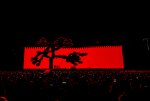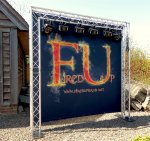Due to some interest being expressed in this subject, & updating / building on a thread I started here years ago (now outdated), I though I'd open the discussion on band lighting in small venues that don't have a dedicated stage. I'm referring to bars, pubs, small halls, & similar places.
In such venues, I see bands either ignore lighting completely, or spend money but get it badly wrong. Lighting is important - especially in smaller venues. Irrespective of the size of band / act, or the genre of music, lighting sets you apart. It turns that corner of a bar into a "stage". Without it, no matter how good you sound, you're all but invisible to the audience - especially an audience who hasn't visited that venue specifically to see you. Lighting announces there's a performance, something to watch, something special.
The following assumes LED. Especially in small venues, the old incandescent lighting has had it's day, both in terms of practicality (heat, delicacy, control, bulk, etc) & power consumption. Many of us remember getting to the venue in a beat up van, only to find half the PAR64s didn't work / broken gels, etc, & spending too much of your gig money on replacement bulbs. Modern LED units are great "IF" you know what to buy. There's still a place for incandescent lighting on larger stages. It's still the gold standard in terms of light quality, but no longer a good choice for smaller venue use.
An important note on LED lighting quality.
Always choose units with RGBW bulbs.
Never buy units with an RGB setup. RGBW bulbs mix the colours within the bulb itself, & also deliver a "pure" white rather than mixing RGB. These typically deliver rich defined colour. RGB units use individual red, blue, & green bulbs to give you the resultant colour. The colours are typically weak / washed out & ill defined.
Always opt for the most powerful units your budget will allow. It's almost always better to have fewer high powered units than more low powered ones, even though multiple units will give a more even light spread. If they're insufficiently powerful for the venue / ambient lighting, most of the impact will be lost. Always better to have headroom.
A final lighting quality note. All of the following suggestions are a small venue compromise in the context of professional lighting standards. In all options here, you will get shadows & dead spots without lighting placed up high & forward of the performers. Such setups will not be covered here, as there's rarely the room available, it requires much more gear in terms of trussing, etc, & often has audience safety / insurance implications too.
Ok, rather than penning the mother of all posts, I'll keep this to absolute essentials / broad guidance, in the hope questions will emerge, & details in replies. I'm grouping this for relevance, in the form of do & don't bullets:
1/ Let's start with the most basic setup. A small band / duo / wine bar / or other low key / low impact setting, or where there's simply no space. As a minimum, you want some colour in your performance area. Something very compact & convenient, yet delivers rich colour.
DO:
* Get two (or more) floor standing floods.
* Choose units with a floor stand / mount & adjustment.
* Choose units with barn doors - these will help direct your light / limit light spill.
* Choose units with manual control menu option, not dip switch DMX.
* Choose units with variable light intensity.
* Choose units that can daisy chain the mains feeds.
* Avoid units that use domestic lighting connections on the units themselves. These tend to be unreliable - especially USA 2 pin / 3 pin connections. Choose units with PowerCon if possible, if not, then IEC.
* Keep your light display static.
* Use a different colour for each flood (unless you want all white). This brings a richness / texture to your presentation.
DON'T:
* Ignore any of the above
* be tempted to use any of the change programs or sound to light - Keep it simple!
* Forget to order power link leads. These mean you can run all lights off one socket, & cuts down on stage cable mess.
2/ Next step up. Basic band flood lighting. Now were elevating the lights - typically either side of the performance area. If you've sourced the floor standing flood lights I describe in section
1/, you can simply stand mount them. Stands come in a range of heights & styles, but the tripod type can take up a lot of space. A single truss tower is a much better option, but require securing to something stable (possibly your PA speaker handles). The other common option is what's known as "Par Bars". These are a stand mounted bar, usually featuring 4 x small floods / spots, & with a built in programming unit. They can be either set to static lighting, program changes, or sound to light.
DO:
* Take note of
all advice in section
1/.
* Mount lights as high as the venue will allow.
* Make sure your power feed leeds are long enough.
DON'T:
* Attach lights to the top of your speakers using tape.
* Set the lights too low so as to dazzle your bandmates.
* Use set change programs or sound to light.
* Suspend power reels. It looks ugly & it's dangerous.
3/ So you want to control your light show. Doing so will add impact and allow you to set moods. Stage flood lighting is all about setting the scene. A static display is always preferable to lights flashing all over the place through sound to light or sequence programs, but performance control adds a next level feel. If you go for the "Par Bar" option, these sometimes come with a foot controller that allows scenes to be programmed & operated by a stage performer. If you go for the more professional stand alone lighting units, there is no such option. With individual units, you'll use DMX control, & that requires a control desk. These desks can be fairly low cost & simple to use, but you'll be relying on someone else to operate the lights for you. You can easily set a selection of "scenes" on the desk for the operator to select with a single button. Frankly, it's not usually difficult to find a volunteer within your band circle. I'll leave the cabling descriptions to questions if asked, but suffice to say, you'll need to run signal leads in addition to mains feed leeds.
DO:
* Keep lighting settings simple. It's about the performers, not the lights. Discourage frequent light scene changes. One scene / verse, one scene / chorus is a good starting guide.
* Ensure signal leads are of sufficient quality & length. Cheap leads = issues.
*
Before buying the gear, if you're going for the ParBar with foot control option, make sure a band member (usually the singer) is happy to operate the lights without detracting from their performance.
DON'T:
* Set scenes that include timed sequences - they never line up with the tempo.
* Use sound to light - it looks sh!t, no matter how much you want to show off your new lights.
4/ Rear stage lighting. Ok, we've covered the basics of flooding the performance area with light, or at least providing some colour to set you apart. Now let's look at impact lighting. This applies mainly to acts wanting a more dynamic presentation. Rear stage lighting is your wow factor. It's designed to give your audience an impression of a "show". These lights can be spot lights if you want to illuminate certain elements, or effects lights such as moonflowers, etc - the list is endless, depending on what you want & how much you have to spend. For small venues, my cover band uses 4 x moonflowers & 2 x spots. A very simple setup that delivers a lot of impact. It goes without saying, once you've decided on rear stage effect lighting, a control desk is a must. Another essential is a hazer (not a smoke machine). A hazer allows your lighting beams to become prominent & adds greatly to the presentation impact. Without one, effects lighting is essentially useless.
Do:
* Take note of all advice in sections
1/ &
2/.
* Pay attention to the footprint of the light mounting stand / stands. Tripod based units are often impractical. Trussing is better, & looks good too.
* Choose the highest power units your budget will allow. This is especially important with effects lighting.
* Carefully integrate your effects lighting with your flood settings. You'll need to dim your floods if you want the effects lights to dominate.
Don't:
* Use a hazer unless you've cleared it with the venue first. Hazers are much less likely to set of smoke alarms than smoke machines, but it's still possible. if the venue isn't happy, don't bring your effects lighting.
* Buy cheap haze fluid.
* Over use effects lighting. Less is definitely more.
Ok, that's enough for a starting guide. Hopefully, some of you will find it useful.
I've attached a few pictures of my cover band's setups. Unfortunately, they're screen shots from videos rather than photo's, so picture quality woeful, but you get the idea. Video links there too if you're interested.
Picture 1 - a tiny & packed
daytime bar gig - zero room - two floor floods. Note: Floods were placed at the performer's feet due to extreme room restriction, & aimed at leg level so as not to dazzle. Daytime too, so worst possible lighting situation, but it still added.
Video:
Pictures 2, 3, 4, & 5 - a medium size bar gig (cap 300) using just 8 light units (2 x floods on truss towers + 2 x spots & 4 x moonflowers)
Video:
Pictures 6 & 7 - our full lighting rig & PA from which we select elements for smaller gigs.
Video:



